Twitter's usage rate surged dramatically following the Great East Japan Earthquake a decade ago. It gained prominence as a means to stay in touch with friends and family even during prolonged power outages.
Since then, Twitter usage has continued to grow. In recent years, more people enjoy Twitter while watching TV, making it an SNS that can support corporate marketing activities in various ways.
This time, we explore the potential of TV × Twitter from an "advertising planning" perspective. We introduce three effects generated by combining TV and Twitter and two key planning points.
Twitter is the most used SNS. About one in three people use TV and Twitter simultaneously.
Twitter is highly valued as a "means to quickly obtain information during emergencies," such as typhoons and other disasters or train delays. Its usage frequency increased even as our lives changed due to the spread of the novel coronavirus. According to Twitter Japan's research, Twitter was the SNS whose usage frequency increased the most due to the impact of the pandemic.
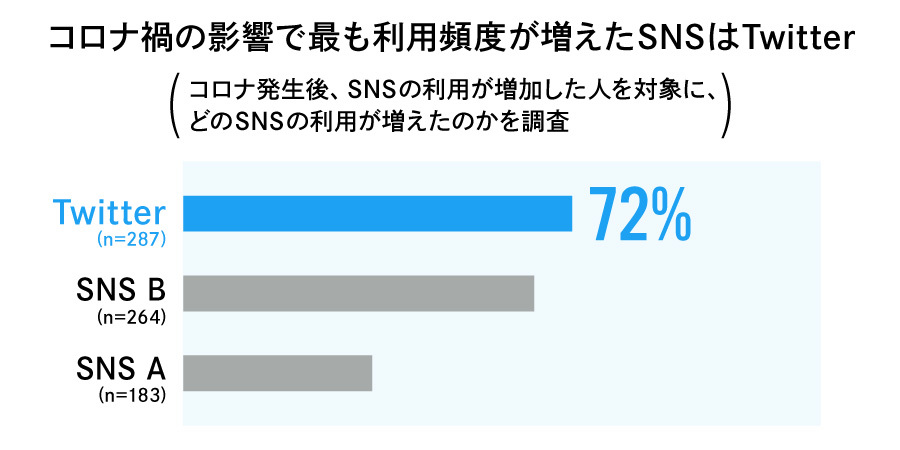
Survey commissioned by: Macromill, Target: Smartphone users aged 18-59 (n=1,000), Survey period: January 2021 (during the state of emergency), Survey area: Greater Tokyo Area, Survey content: Investigated changes in SNS usage frequency due to the impact of the novel coronavirus. Respondents who used each SNS at least once a month were included in the analysis. Respondents were asked to rate, on a 5-point scale, which activities they spent more time on compared to before the COVID-19 outbreak. Those who answered their SNS usage had "increased" or "slightly increased" were defined as "SNS users showing increased usage." Next, these "SNS users showing increased usage" were asked to rate changes in their usage of each SNS, including Twitter, on a 5-point scale. The graph above shows the percentage of respondents who answered "increased" or "slightly increased" for each question.
Twitter has consistently had higher usage rates than Facebook and Instagram among those under 40. However, its usage rate among those aged 40 and above has also been increasing year by year. In November 2020, Twitter surpassed Facebook, which had previously been the top SNS platform, in usage rate (according to Dentsu Inc. d-campX research). This data further confirms that Twitter is an SNS with high usage rates regardless of age.
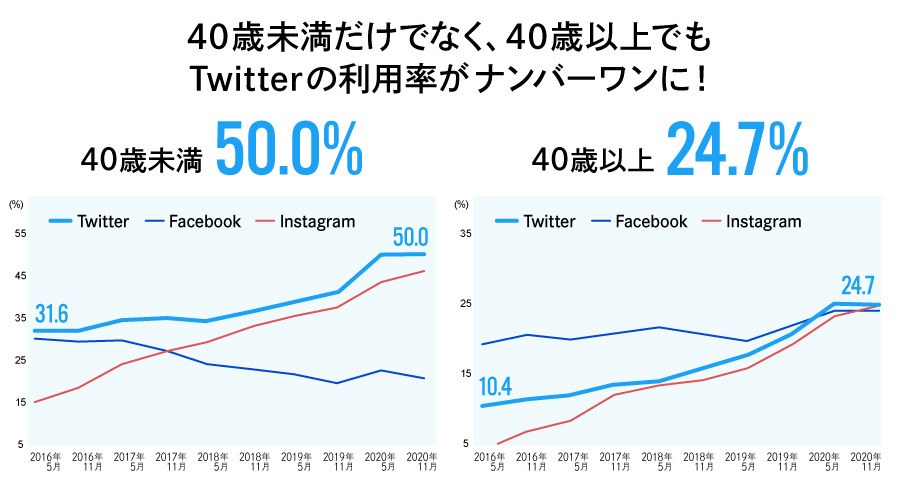
Source: d-camp X 2020 Second Half, Research Organization: Dentsu Inc., Survey Participants: 2,786 men and women aged 40 and above, 2,324 men and women under 40, Survey Period: May 2016 - November 2020, Survey Area: Within 50km of Tokyo, Survey Method: Persuasion of participants through visits, electronic survey forms using tablet devices
Looking at the usage rate for the article's theme, "TV × Twitter," approximately 30% of Twitter users used Twitter while watching TV at least once a week and tweeted about the programs. This behavior has increased significantly by 169% compared to five years ago.
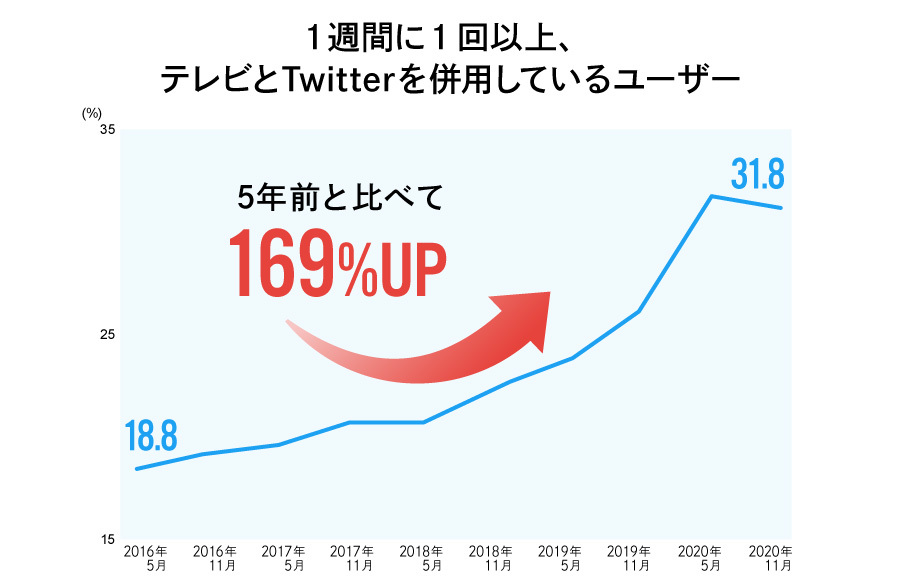
Source: d-campX, Research Agency: Dentsu Inc., Survey Sample: 5,110 men and women aged 12–69, Survey Period: May 2016–November 2020, Survey Area: Tokyo 50km radius, Survey Method: Persuasion of survey participants through visits, Electronic survey forms via tablet devices
TV stations have also established official Twitter accounts for their programs. They increasingly leverage Twitter alongside their shows, running giveaway campaigns tied to Twitter and featuring viewers' tweets during broadcasts. Twitter's presence in TV programming is expected to grow further as a means of interactive communication with audiences.
TV × Twitter advertising campaigns generate reach effects, brand lift effects, and tweet generation effects
With the proliferation of smartphones and social media, combining TV commercials with digital advertising to maximize advertising effectiveness has become essential for successful advertising campaigns.
When doing so, it's crucial not to allocate budgets based solely on "user numbers = reach" or "exposure volume = impressions," but rather to identify the characteristics of each SNS and digital ad format and combine them effectively. So, what are the key features of the "effectiveness of advertising campaigns" that combine TV commercials and Twitter ads?
① Reach Effect: Increased Integrated Campaign Reach
Twitter ads can reach audiences not reached by TV commercials alone, making it easier to increase overall reach. This is particularly noticeable when targeting younger demographics, which are crucial for companies conducting marketing activities.

Source: Kantar Japan, CrossMedia AdEffect™, Survey Period: January 2020, Survey Participants: Men and women aged 18-34 (n=682) and 35-49 (n=837) residing in the Kanto region
② Brand Lift Effect: Attitudes toward the brand are more likely to change
Repeated exposure to ads across TV and Twitter tends to lift "awareness," "intent," and "action" for the ads.
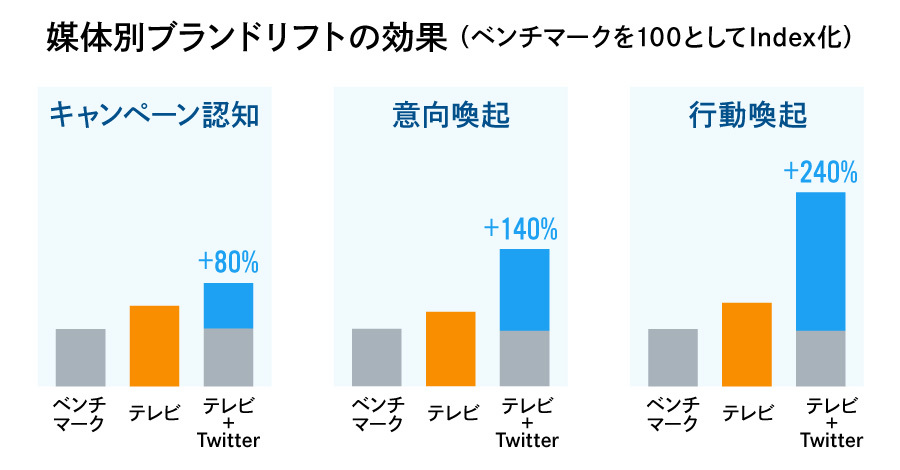
Source: Kantar Japan, CrossMedia AdEffect™, Survey Participants: Men and women aged 18-49 residing in the Kanto region (n=1,519), Survey Period: January 2020, Benchmark... TV FQ (Frequency) <3 and Twitter FQ <1.5, TV... TV FQ ≥3 and Twitter FQ <1.5, TV+Twitter... TV FQ ≥3 and Twitter FQ ≥1.5
While reach and brand lift effects occur to some extent when combining TV commercials and digital ads, campaigns combining TV commercials and Twitter ads demonstrate significantly higher effectiveness.
This is likely due to the high rate of concurrent Twitter and TV usage, combined with Twitter's unique characteristic where TV programs and commercials become real-time topics on the platform, facilitating easy dissemination. We believe this strong synergy with TV is a major feature not found on other SNS platforms.
③ Tweet Generation Effect: Increased Brand-Related Tweets
And the third point is truly unique to Twitter. When TV commercials and Twitter ads are run simultaneously, they can efficiently generate "tweets about the brand" more effectively than when only TV commercials are run.
While advertising typically increases brand-related tweets to some extent, running TV commercials and Twitter ads concurrently creates more opportunities for tweeting. This is because, as mentioned in points ① and ②, it allows brands to reach more people (reach effect) and boost awareness and intent/action (brand lift effect).
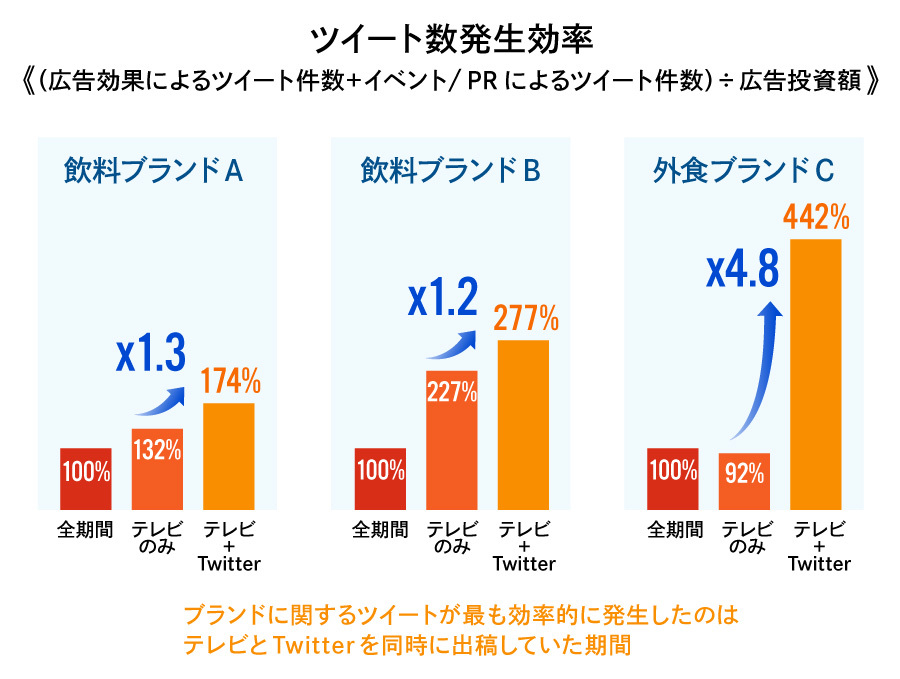
Source (Study Name): "Study on Synergy Effects Between TV and Twitter"; Research Organization: Kantar Japan; Research Period: Beverage Brand A...September 2015 to September 2017, Beverage Brand B...September 2015 to September 2017, Restaurant Brand C...June 2015 to October 2017; Research Method: Analyzed the relationship between advertising investment and tweet volume using Kantar Japan's Digital Behavior Analysis model, based on the number of tweets and advertising expenditure for beverage and food brands
Furthermore, Twitter Japan research has demonstrated that "brand-related tweets" influence the user purchase process, highlighting the importance of increasing brand-related tweets.
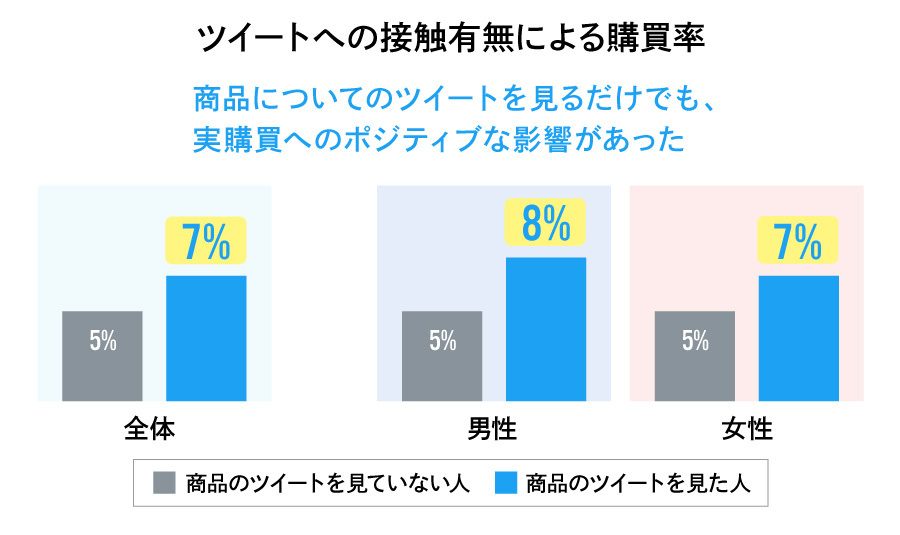
Source: Intage, NTT DATA, and Twitter; Survey subjects: Product tweet exposed individuals (n=2,448), including males (n=1,534), females (n=914) / Product tweet unexposed individuals (n=4,267), including males (n=2,642), females (n=1,625)※ Significance test conducted at 90% confidence interval. Survey period: August 2017
TV × Twitter Planning: Two Key Points
So, how should TV commercials and Twitter ad campaigns be planned together?
Point ①: Divide the campaign period into three phases and run Twitter reserved ads aligned with the CM
It is crucial to design Twitter ad campaigns by dividing them into three phases starting from the launch date: "Teaser," "Launch," and "Sustain." This is because each phase has distinct objectives and effects, as shown in the diagram below. By deploying Twitter ads according to each phase, it is possible to boost the overall effectiveness of the campaign.
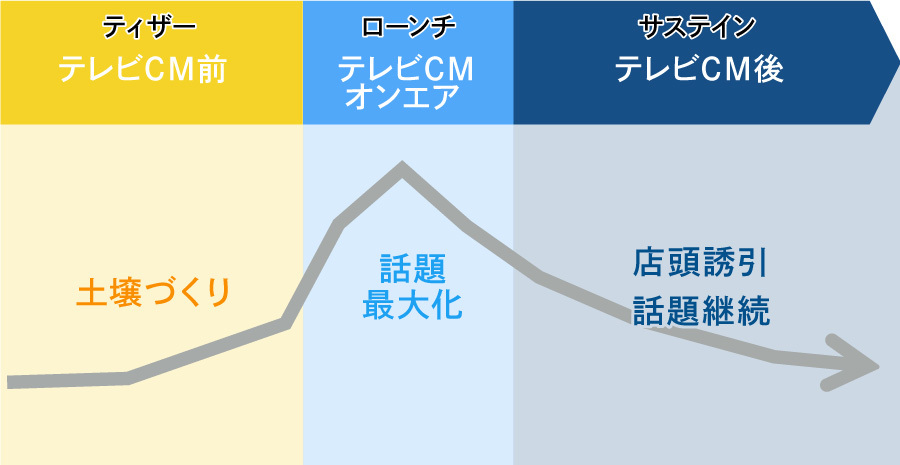
For campaigns centered around TV commercials, it is crucial to design the phases aligned with the commercial's launch date.
Rather than launching the TV commercial immediately, the teaser phase lays the groundwork. Here, initiatives are deployed to spark interest among the target audience beforehand, thoroughly preparing fertile ground for the ad's impact. Then, timed with the TV commercial launch, Twitter's reservation-based ads—purchasable on a daily basis and capable of achieving high reach—are implemented to maximize reach and buzz.
After the TV commercial launch, the campaign continues using performance-based products that allow flexible design of the display period and operational content to match the campaign, maintaining touchpoints with the brand. Thus, the key to advertising campaigns utilizing Twitter is to design the campaign period into three distinct phases, creating touchpoints with the target audience tailored to each phase's specific objective.
Point 2: Reach people who "enjoy Twitter while watching TV"
In the first and second articles of this series, we noted that the segment "enjoying Twitter while watching TV" not only has high satisfaction with programs and commercials but also experiences "low stress, positivity, and significantly increased ad recall" toward advertising. In other words, effectively capturing this segment presents a chance to boost marketing success.
Dentsu Inc. advocates a new, people-centric TV planning approach called "People Driven TV Planning." This enables detailed extraction and visualization of marketing targets, revealing what programs they watch. By also integrating PC and smart device usage data and survey responses, it allows for the creation of highly refined target profiles.
When we actually created TV viewership data for users who simultaneously use TV and Twitter, variety shows and dramas showed high ratings, indicating these are program genres well-suited to Twitter users. Below are the top 10 programs each for "Highest Viewership" and "Highest Viewership Difference."

Source: es XMP, Research Organization: Video Research Ltd., Survey Population: 6,000 males and females aged 15-69 in the Kanto region (Tokyo and 6 prefectures), Survey Period: February 15 - March 14, 2021, Acquisition Method: Mechanical
Thus, by utilizing the evolved TV planning approach "People Driven TV Planning," it becomes possible to efficiently reach the audience who "enjoy Twitter while watching TV" through TV commercials.
The synergy between TV and Twitter is exceptionally strong, and I believe TV programs and advertising campaigns utilizing Twitter will continue to increase. This is because Twitter is becoming a platform for enjoying television.
In advertising planning, a key design point is how to link the "real moments" created by TV with Twitter to engage the target audience. This approach ultimately drives the overall effectiveness of the campaign.
















